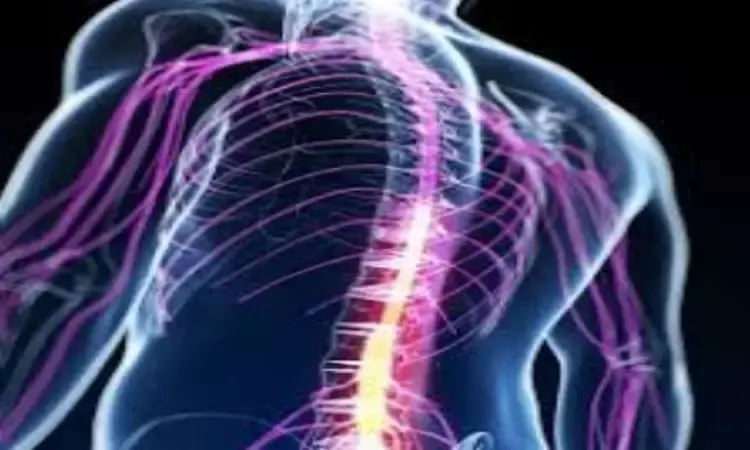- Home
- Medical news & Guidelines
- Anesthesiology
- Cardiology and CTVS
- Critical Care
- Dentistry
- Dermatology
- Diabetes and Endocrinology
- ENT
- Gastroenterology
- Medicine
- Nephrology
- Neurology
- Obstretics-Gynaecology
- Oncology
- Ophthalmology
- Orthopaedics
- Pediatrics-Neonatology
- Psychiatry
- Pulmonology
- Radiology
- Surgery
- Urology
- Laboratory Medicine
- Diet
- Nursing
- Paramedical
- Physiotherapy
- Health news
- Fact Check
- Bone Health Fact Check
- Brain Health Fact Check
- Cancer Related Fact Check
- Child Care Fact Check
- Dental and oral health fact check
- Diabetes and metabolic health fact check
- Diet and Nutrition Fact Check
- Eye and ENT Care Fact Check
- Fitness fact check
- Gut health fact check
- Heart health fact check
- Kidney health fact check
- Medical education fact check
- Men's health fact check
- Respiratory fact check
- Skin and hair care fact check
- Vaccine and Immunization fact check
- Women's health fact check
- AYUSH
- State News
- Andaman and Nicobar Islands
- Andhra Pradesh
- Arunachal Pradesh
- Assam
- Bihar
- Chandigarh
- Chattisgarh
- Dadra and Nagar Haveli
- Daman and Diu
- Delhi
- Goa
- Gujarat
- Haryana
- Himachal Pradesh
- Jammu & Kashmir
- Jharkhand
- Karnataka
- Kerala
- Ladakh
- Lakshadweep
- Madhya Pradesh
- Maharashtra
- Manipur
- Meghalaya
- Mizoram
- Nagaland
- Odisha
- Puducherry
- Punjab
- Rajasthan
- Sikkim
- Tamil Nadu
- Telangana
- Tripura
- Uttar Pradesh
- Uttrakhand
- West Bengal
- Medical Education
- Industry
Sacral Neuromodulation device may be retained by overactive bladder patients with over 75% symptoms improvement

In a new study sacral neuromodulation (SNM) for overactive bladder has been reviewed to determine if the degree of improvement after SNM-I is sufficient predict long-term success.
According to a recent study, researchers have found out that Compared to patients reporting 50%-75% symptomatic reduction in overactive bladder after SNM-I, individuals with a more than 75% improvement during SNM-I were more likely to maintain device efficacy over time.
The study is published in the Neurology and Urodynamics.
A ≥50% subjective improvement in urinary symptoms during sacral neuromodulation testing (SNM-I) is currently used as the indication for progression to second-stage implantation (SNM-II). While most patients will have successful SNM-I and proceed to SNM-II, deterioration in efficacy over time has been reported. It remains unclear if the durability of efficacy is related to the initial symptom reduction.
Therefore, David K Charles and colleagues from the Department of Urologic Surgery, Medical College of Wisconsin, Milwaukee, Wisconsin, USA carried out the present study with the objective to determine if the degree of improvement after SNM-I is sufficient to predict long-term success.
The records of all patients who underwent sacral neuromodulation (SNM) for overactive bladder were reviewed. Subjects were divided into those who reported 50%-75% improvement (Group 1) and more than 75% improvement (Group 2) after SNM-I. Differences in clinical variables and long-term device efficacy were compared between groups.
The following findings are revealed-
a. Of 213 patients who underwent SNM-I, 137 underwent permanent device implantation.
b. A total of 76 (55%) and 61 (45%) patients reported 50%-75% (Group 1) and more than 75% (Group 2) symptomatic improvement, respectively.
c. With a mean follow-up of 46 months, 44% of Group 1 patients and 68% of Group 2 patients still had a functioning device providing the symptomatic benefit (p = 0.007).
d. Univariate analyses identified the presence of stress urinary incontinence at baseline and having a more than 75% improvement after SNM-I as predictors of long-term functional success.
Hence, the authors concluded that "Compared to patients reporting 50%-75% symptomatic reduction after SNM-I, individuals with a more than 75% improvement during SNM-I were more likely to maintain device efficacy over time."
However, additional study is warranted to determine if the improvement threshold for progression to SNM-II should be increased.
For further reference log on to:
Dr. Nandita Mohan is a practicing pediatric dentist with more than 5 years of clinical work experience. Along with this, she is equally interested in keeping herself up to date about the latest developments in the field of medicine and dentistry which is the driving force for her to be in association with Medical Dialogues. She also has her name attached with many publications; both national and international. She has pursued her BDS from Rajiv Gandhi University of Health Sciences, Bangalore and later went to enter her dream specialty (MDS) in the Department of Pedodontics and Preventive Dentistry from Pt. B.D. Sharma University of Health Sciences. Through all the years of experience, her core interest in learning something new has never stopped. She can be contacted at editorial@medicaldialogues.in. Contact no. 011-43720751
Dr Kamal Kant Kohli-MBBS, DTCD- a chest specialist with more than 30 years of practice and a flair for writing clinical articles, Dr Kamal Kant Kohli joined Medical Dialogues as a Chief Editor of Medical News. Besides writing articles, as an editor, he proofreads and verifies all the medical content published on Medical Dialogues including those coming from journals, studies,medical conferences,guidelines etc. Email: drkohli@medicaldialogues.in. Contact no. 011-43720751


